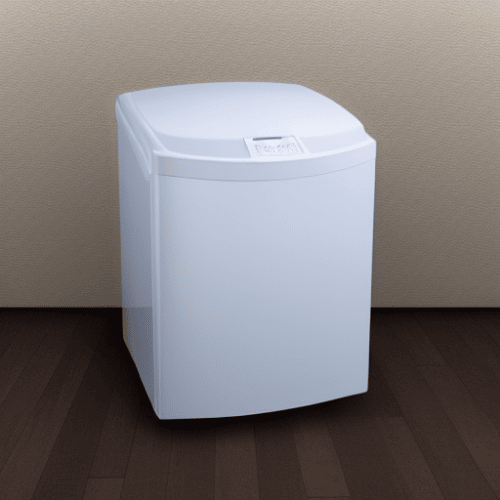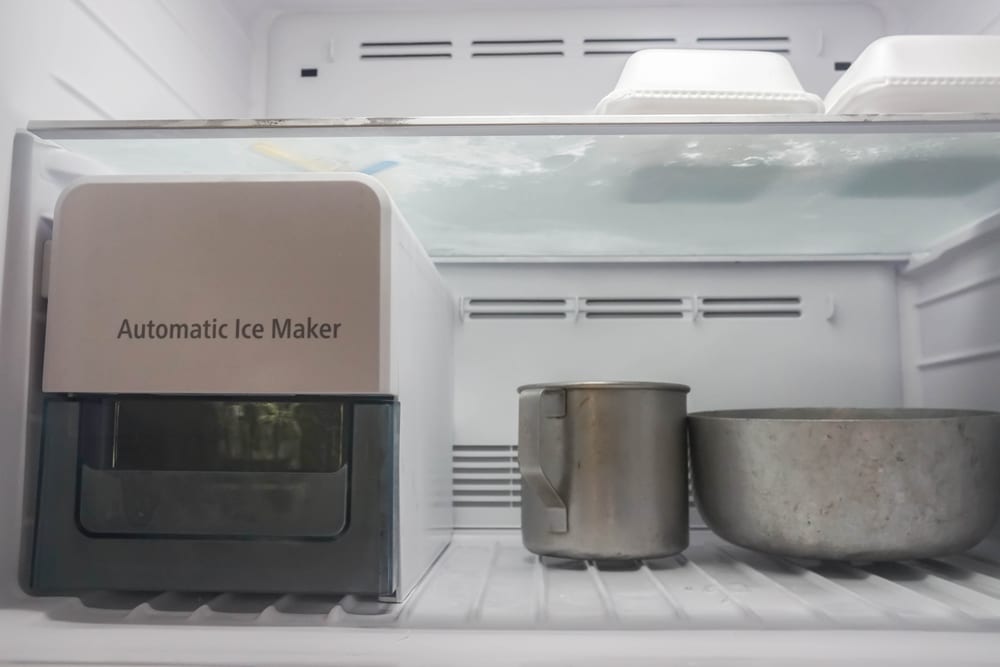Last Updated on
Do you love cold drinks? Then an ice machine is a must-have for you – especially during the summer months. You will be able quickly and easily cool your drink using an ice maker so that you can enjoy it on a warm, bright day.
So that you understand how they work and whether ice machines are a worthy investment, we have put together this article to guide you through the ins and outs of an ice maker.
How Does an Ice Maker Work?
The ice maker will begin producing ice cubes once it is connected to a power and water supply. Towards the beginning of the cycle, the ice maker sends an electrical signal to a water valve, filling the ice tray up to a certain water line with – you guessed it – water. Then, the freezing process begins. Once the freezer temperature and the internal thermostat are between -15 °C and -12 °C, the process will stop.
With the ice cubes now ready in the ice moulds, the ice machine loosens each ice cube to fill the ice storage bin. For this, a heating coil activates and loosens the frozen water. Once the ambient temperature is slightly higher, the ice maker’s blades push the ice out of the moulds and into a funnel that then collects the cubes in an ice tray.
After this point, a shaft separates the freeze tray from the dispenser, which is opened when a button or a lever is pressed.
This process will continue to operate until the shut-off arm sends a signal that there’s enough ice.
Reasons Why Your Ice Maker Isn’t Working
Although the above description of how an ice maker works may make it seem that your ice maker’s mechanisms are simple, the start-to-finish process is, of course, a bit more complex, and you may experience some issues or difficulties when trying to get your ice maker to work.
If your unit is struggling to produce ice, below are some factors contributing to this problem and how you can fix them. Most ice makers will have similar problems; however, commercial ice makers may need to be inspected by a professional, especially if there is an issue with the refrigeration and refrigeration systems.
Ice Is Caught in the Raker
One common issue that can be why your ice maker is no longer producing ice is that solid water is caught in the raker. This is the ice maker responsible for raking through cubes to add new ones to the ice trays. It plays a significant role in preventing the creation of huge ice chunks that can clog up the system. If an ice block becomes jammed, it can prevent the raker from doing its job properly.
To fix this issue, you’ll need to remove the ice that’s blocking the raker. Usually, you can easily see if the raker arm is stuck and reach inside to unclog any ice. Most commonly, the raker can get caught because there’s too much ice in the ice maker, meaning that you should remove any buildup of ice, too.
The Dispenser Is Blocked

Alternatively, perhaps your machine is no longer making ice because the dispenser is clogged. The ice chute can commonly get jammed, meaning that no ice will be dispensed when you press the lever. When this happens, your first step should be to check the ice bin in the freezer. If you notice a blockage in the dispenser, fish out any ice that is jammed.
If you’re unable to fix this because there’s a huge chunk of ice lodged inside, you may have to unplug the ice machine and play the waiting game until the ice has completely melted. Ensure that you have something underneath the dispenser to catch any ice cubes and water draining away so that you don’t end up with a big puddle on your kitchen floor.
The Auger Motor Is Frozen
Another reason why your ice machine is struggling with the ice-making process is if the auger motor is frozen. This can happen if you haven’t used your machine in a long time. If the auger motor is frozen, its ability to spin and bring the ice down into the ice bucket and chute is inhibited.
This problem is, in most cases, easy to fix. Keep the dispensing lever pushed until the auger motor begins to run again. This will let the motor warm up, thus, melting the ice that was freezing it in place.
However, please note that the warming of the motor can cause a lot of strain on ice machines and, therefore, may not be the best solution. Furthermore, keep an eye on the water flows and melting moisture, as the chilled water may damage the motor.
Benefits of an Ice Maker
There are many benefits of owning ice makers. Below are some of our favourite reasons why we recommend adding an ice cube machine to your kitchen setup.
Convenience
How many times have you wanted to pour cold drinks on a hot day only to discover that you didn’t chill beverages or any ready ice cubes in the freezer? Fortunately, an ice maker provides you with the convenience of instantly having ice available.
Ease Of Use
Impressively, ice makers are super easy to use. Plus, you’ll never have to worry about buying or making your ice again. So long as your ice machine continues to function properly, you don’t need to undergo any steps to have a ready supply of ice whenever you need it. So there’s no work required from you.
Exceptional Cleanliness
If you don’t own an ice machine, the chances are that you’ve been using ice trays in your freezer. But when was the last time you thoroughly cleaned your freezer? Instead, it’s probably riddled with leftover food and crumbs, which can find their way into your ice. Fortunately, ice makers are separate from your food, helping to enhance the hygiene in your kitchen.
Make Life Easier With an Ice Maker
In short, an ice machine works by filling a mould with water that then freezes. The ice produced is then loosened from the mould by a heating coil while the machine forces ice to end a funnel and into an ice tray.
It is a clever appliance that facilitates ice production and makes your life just that little bit easier, especially if you enjoy a cold drink on a hot day.
Amy is a U.K.-based writer and editor with a penchant for helping consumers find the best home products for their needs, as well as providing easily digestible guides for living better at home. Her dedication to her work means she can usually be found elbow-deep in research or hunting down samples of the latest and greatest on behalf of her readers.
An avid DIYer herself, Amy’s passion lies in teaching others how they too can achieve their dream homes by tackling some of those pesky projects themselves! Whether it’s building furniture from scratch or turning an old dresser into a coffee table, Amy is always happy to share what she knows about making your house feel like home without spending a fortune.



